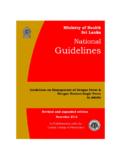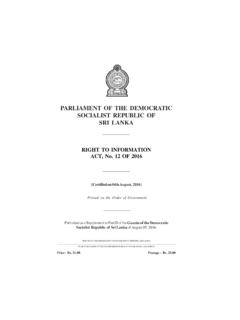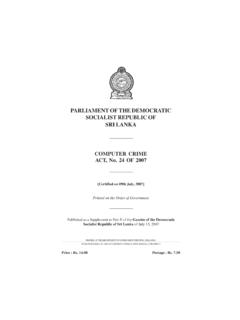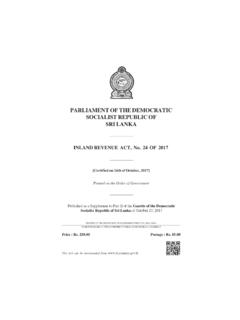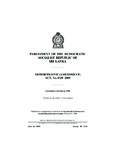Transcription of COMPREHENSIVE MULTI-YEAR PLAN FOR …
1 Ministry of Health Government of the democratic socialist republic of Sri Lanka COMPREHENSIVE MULTI-YEAR plan FOR immunization 2012 - 2016 Expanded Programme on immunization Directorate General of Health Services I CONTENTS Table of contents I Acknowledgements II Executive summary III Acronyms V List of tables VI List of figures VI 1 Introduction 1 Country profile 1 Current situation of the health sector 3 multi year plan for immunization 7 2 Situational analysis of the immunization programme in Sri Lanka 10 Historical perspective 10 Programme objectives 12 Organization and management of the EPI 13 Vaccine procurement 15 Vaccine supply 15 immunization coverage 15 Current vaccine preventable disease burden 18 Availability and maintenance of cold chain facility 19 Ensuring injection safety 21 Vaccine wastage 24 Quality of the immunization services 24 Strengthening EPI surveillance EPI
2 Network 26 Strengthening training and research activities 27 Introduction of new antigens/combined vaccines into the EPI 27 Control of vaccine preventable disease outbreaks 29 Risks and challenges identified 31 Private sector collaboration 31 3 Future budget requirements 33 Budget Requirement 33 Sources of secure/probable funding 37 4 National level problems, objectives and priorities related to the immunization programme 38 5 Objectives, strategies and key activities of cMYP 41 II ACKNOWLEDGEMENTS Contributors 1. Dr Paba Palihawadana Chief Epidemiologist Epidemiological Unit, Colombo 10. 2. Dr A.
3 Amarasinghe Consultant Epidemiologist Epidemiological Unit, Colombo 10. 3. Dr P. S. Ginige Consultant Epidemiologist Epidemiological Unit, Colombo 10. 4. Peiris Assistant Epidemiologist Epidemiological Unit, Colombo 10. III Executive Summary The Expanded Programme of immunization (EPI) in Sri Lanka is an integral component of the public health system. The main objective of the country s EPI is to reduce morbidity and mortality associated with vaccine preventable diseases. The unique feature of the immunization services in Sri Lanka is that for over three decades, it is integrated with the other primary health care services at all levels.
4 Therefore service providers and other logistics are shared with other public health activities as a routine. Sri Lanka s national immunization programme is frequently quoted as one of the strongest performers, not only in the region, but also in the world. The National EPI programme has an excellent record, with extremely low incidence of EPI diseases and high coverage of all EPI vaccines. However, unless the country pays attention to key issues of programme quality and timely introduction of newer vaccines according to the needs it could lose the advantages it has gained in disease control over the last 30 years. The EPI is one of the priority public health activities to which the government of Sri Lanka has given due attention even during any economic and political crisis.
5 The main source of the government s health expenditure is the consolidated fund and the balance comes as foreign aid. Compared to the total external funding into the health sector, the amount of donor funding for immunization is proportionately very low. It is of utmost importance to highlight that the immunization programme in Sri Lanka is self funded, as nearly 98% of the cost is borne by the Government of Sri Lanka. This demonstrates good evidence of financial sustainability in the past. WHO, GAVI and UNICEF are the leading international donors supporting and covering the balance two percent. Though, the sharing of government has declined 98% in 2002, to 92% in 2004, the actual amount spent has increased by US$ million.
6 GAVI funding during this review period has caused slight decline in the government proportion. COMPREHENSIVE multi year plan (CMYP) for immunization is a key management tool for the national immunization programmes, and in recent years managers have been asked to develop different plans to reach different immunization objectives. Developing a CMYP presents an opportunity to consolidate existing plans into a single document that addresses global, national and sub-national immunization objectives and strategies efficiently, and that also evaluates the cost and financing of the plan . CMYP articulates the future vision for the immunization programme in Sri Lanka.
7 IV The expansion of immunization activities, including polio eradication, measles elimination, elimination of neonatal tetanus, introduction of new vaccines and safer vaccination technologies have increased the need for coordination and a COMPREHENSIVE response to planning and budgeting for the sustainability of the programme. High cost of all new vaccines will be a real challenge to ensure the balance between the sustainability and the expansion of the programme according to the current need. By putting the various pieces together into one process and document, the CMYP makes it easier for the immunization programmes to set priorities, plan for implementation, and identify interactions across programmes.
8 At the same time by assessing changes in the health sector and the political and economic situation, immunization managers can anticipate changes in funding flows or methods of service delivery in order to plan sustainable improvements. This CMYP document sets out the medium term goals, related objectives, strategies, indicators and associated costs for the period of five years starting from January 2012 to December 2016. The key areas identified to be improved during this period are: maintaining the high coverage of vaccines administered during the first year of life; Coverage of vaccines administered during school going age; Laboratory confirmation of reported EPI target diseases; Availability of adequate cold chain at all levels; routine detailed investigation of serious AEFI at divisional level; reduce EPI vaccine wastage; prevailing disparity in the quality of immunization services within and between districts; inadequate and maldistribution of health personel; Vaccine transport facilities at all levels.
9 EPI related disease surveillance activities; training and research activities related to immunization ; introduction of new antigen into the EPI programme; private sector contribution towards immunization ; and financial sustainability of the immunization programme. Sri Lanka is planning to introduce Pneumococcal and HPV vaccines into the national EPI programme from 2013 and 2014 respectively. For this purpose Sri Lanka will necessarily be looking for donor support. It will require an additional US$14 million annually and this will be around 92% of the cost of the total immunization programme. V Acronyms The following acronyms are used in this document.
10 AD Auto-disable syringe AEFI Adverse event following immunization AFP Acute flaccid paralysis a TD Adult tetanus and diphtheria vaccine DT Diphtheria and tetanus vaccine BCG Bacilli Calmette-Guerin (tuberculosis vaccine) CMYP COMPREHENSIVE MULTI-YEAR plan RDHS Deputy provincial director of health services DTP Diphtheria-tetanus-pertussis vaccine DPT1 First dose of diphtheria-tetanus-pertussis vaccine DPT2 Second dose of diphtheria-tetanus-pertussis vaccine DPT3 Third dose of diphtheria-tetanus-pertussis vaccine EPI Expanded programme on immunization EVSM Effective vaccine system management FHB Family health bureau GAVI Global alliance for vaccines and immunization GDP Gross domestic product GNP Gross national product GTN Global training network Hep B Hepatitis B vaccine Hib Hemophilus influenzae type b
